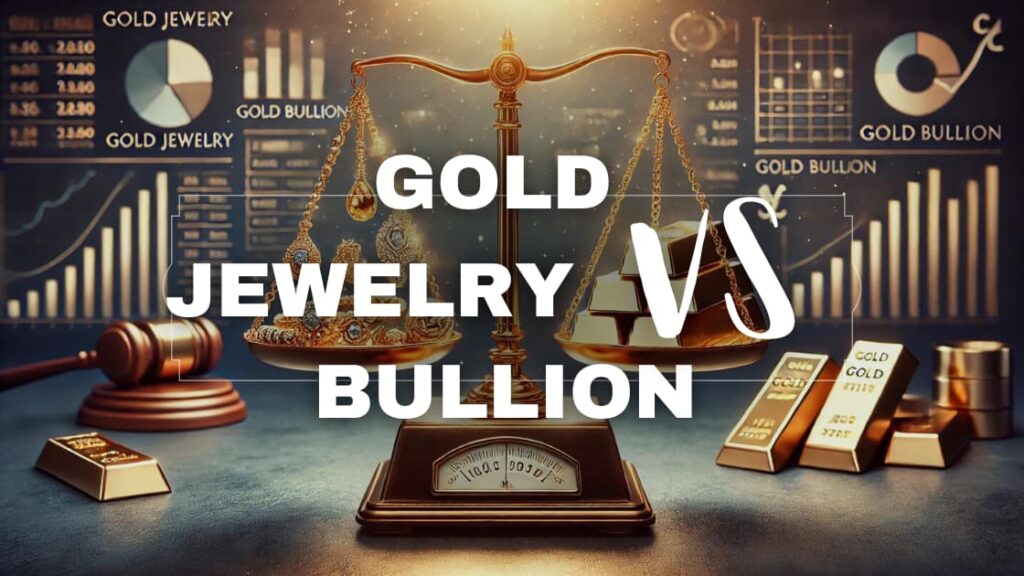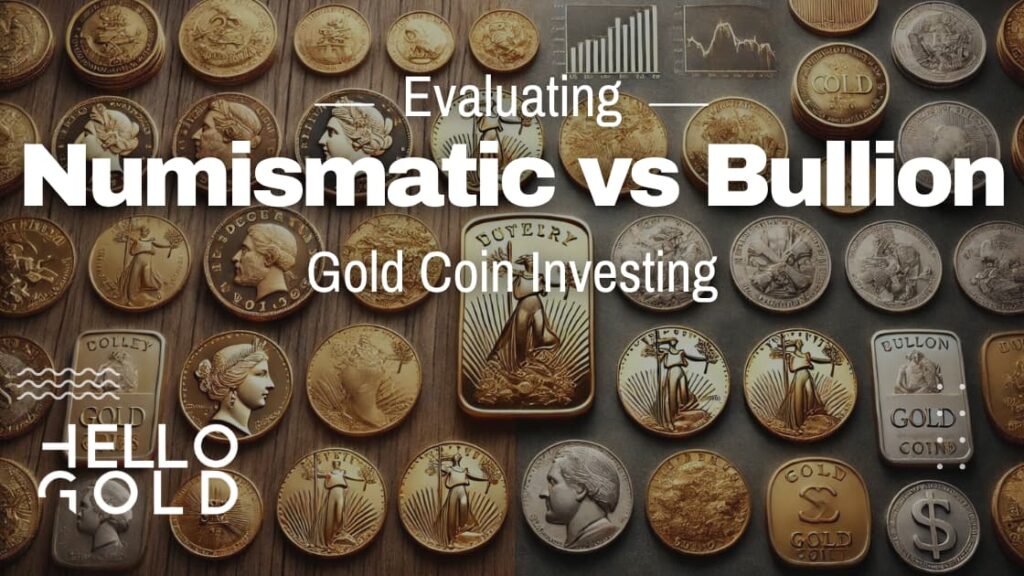Gold is a popular way to invest money, but should you put your cash into jewelry or bullion?
These two have big differences that impact your money goals.
This article explains jewelry versus bullion so you choose the right gold investment for your financial future.
Understanding Gold as an Investment
You’re considering investing in gold, but you’re not sure where to start. Gold comes in various forms, and it’s essential to understand the differences between them.
Gold Jewelry vs. Bullion: What’s the Difference?
Let’s begin by defining gold jewelry and bullion.
Gold jewelry is a wearable investment that can take many forms, from intricate earrings to elaborate necklaces. Jewelry gold is typically alloyed with other metals to enhance its durability and achieve different colors, affecting its purity.
You may have come across terms like 10K, 14K, 18K, or 24K, which refer to the purity of the gold. The higher the karat, the purer the gold content, but also the softer the metal.
On the other hand, gold bullion is a more straightforward investment, valued solely for its gold content.
Bullion is standardized for high purity, usually 99.5% or higher, and comes in various forms, including bars, coins, or rounds.
Unlike jewelry, bullion doesn’t carry additional design or craftsmanship costs, making it a more cost-effective option for investors.
The manufacturing process for jewelry involves intricate design and craftsmanship, resulting in higher costs beyond the gold content. In contrast, bullion production focuses on creating standardized, high-purity gold bars or coins with minimal artistic intervention, keeping production costs lower.
The Global Gold Market: An Overview
Now, let’s take a step back and look at the bigger picture.
The global gold market is a complex system, with tentacles reaching into finance, industry, and even geopolitics.
Gold jewelry and bullion are the two major segments, with jewelry holding a substantial market share due to cultural and personal value.
Major players in the gold market include countries with significant gold reserves, as well as institutions like central banks and individual investors. The gold market is influenced by diverse factors, including geopolitical tensions, economic performance, and currency fluctuations.
Gold prices are driven by global supply and demand dynamics, investor sentiment, and macroeconomic indicators.
For instance, during economic downturns, gold prices tend to rise as investors flock to safe-haven assets.
Conversely, during periods of economic growth, gold prices may stabilize or decline as investors pursue higher-yield opportunities.
You should be aware that the gold market is subject to various risks, including market volatility, regulatory changes, and geopolitical events. It’s essential to understand these risks and how they may impact your investment decisions.
Breaking Down the Costs
Understanding the costs associated with gold investments is crucial for making smart decisions. Whether you choose gold jewelry or bullion, each comes with its own set of expenses that can significantly impact your investment potential.
The Hidden Expenses in Gold Jewelry
Gold jewelry carries a complex cost structure that extends far beyond the basic value of its gold content. Several factors add to the price you pay:
Design and craftsmanship costs are a major part of the markup. Skilled labor and unique designs command high prices.
Brand premium is another factor, as luxury brands often charge a lot more for their pieces due to their reputation and perceived value.
Retail overhead and marketing expenses also add to the final price. Each middleman in the supply chain, from manufacturers to wholesalers to retailers, adds their own markup.
These factors can result in jewelry prices that far exceed the value of the gold content. For example, a piece of gold jewelry might be priced at $100 per gram, while the actual gold content value could be less than half that amount.
A key term to understand is “melt value” – the worth of the gold if the jewelry were melted down.
For instance, 14-karat gold contains only 58.3% pure gold. This means a 14K gold ring weighing 10 grams contains just 5.83 grams of pure gold.
The difference between the jewelry’s price and its melt value represents the premium you’re paying for design, brand, and other non-gold factors.
Bullion Pricing: What You’re Really Paying For
Bullion pricing is more straightforward, but still involves several parts:
The spot price of gold is the current market price, which changes based on global supply and demand.
The premium over spot is the extra cost above the spot price. Premiums vary based on the type of bullion, market demand, and dealer policies.
Dealer fees are additional charges imposed by the seller.
Let’s break this down with an example.
If gold is trading at $1,800 per ounce on the market, a 1-ounce gold bar might sell for $1,850.
The $50 difference represents the premium over spot.
If the dealer charges an extra $20 fee, your total cost would be $1,870.
Premiums can vary a lot between different types of bullion.
For example, larger gold bars might have lower premiums compared to smaller ones due to lower production costs.
Some bullion products may carry higher premiums due to their unique features, such as special minting processes or limited edition designs.
When investing in bullion, it’s crucial to calculate the true cost by considering all these factors. Buying in larger quantities can often result in lower per-ounce costs due to bulk discounts.
Long-term Cost Considerations
Both gold jewelry and bullion come with ongoing costs that can impact your investment’s long-term performance:
Storage costs are essential for protecting your investment. This could involve home safes, bank safety deposit boxes, or third-party storage facilities.
Bullion typically needs less space and might be easier to store securely compared to jewelry.
Insurance costs are also important for protecting your gold investment against theft or damage. Insurance for jewelry can be more expensive due to its higher replacement value and increased risk of loss or theft.
Maintenance costs are another consideration. Gold jewelry may require regular cleaning and repairs, adding to its long-term cost.
Bullion, on the other hand, needs minimal upkeep.
Transaction costs, including dealer commissions and potentially shipping fees, apply when buying or selling gold. These costs are generally lower for bullion compared to jewelry due to the standardized nature of bullion products.
Liquidity costs are also a factor.
When it’s time to sell, jewelry often faces significant depreciation due to its retail markup.
Bullion, being valued primarily for its gold content, typically keeps a higher percentage of its purchase price.
Liquidity: Turning Your Gold Back into Cash
The value of an asset like gold isn’t just in how well it grows over time, but also in how easily you can turn it back into cash.
Regardless of the form your gold investment takes, you need to be able to convert your investment quickly and efficiently.
The ease with which you can sell both types of gold differs a lot, and understanding these differences is important for making smart investment decisions.
The Challenges of Selling Gold Jewelry
When you decide to sell your gold jewelry, you face some unique challenges that can impact what you get back for it.
Several factors affect how much your jewelry is worth when you want to sell it. For example, how well you’ve taken care of it can make a big difference. A piece that’s been worn a lot is probably going to sell for less than one that’s barely been touched, even if they both have the same amount of gold in them.
The current popularity of the design is also a big deal. A style that was once all the rage might not sell as well if it’s no longer in fashion.
The reputation of the brand also plays a role. Well-known, high-end brands like Cartier or Tiffany might hold their value better because people respect their name. Lesser-known brands might not do as well, no matter how much gold is in the piece.
The purity of the gold in the jewelry is also important. Jewelry made with higher purity gold (like 18K or 22K) usually sells for more than pieces made with lower purity gold (like 10K or 14K) because it has more actual gold in it.
The process of selling gold jewelry can take time and might cost you. Professional appraisals give you an accurate value, but you pay for that accuracy.
Pawn shops can give you quick cash, but they usually only give you a fraction of what the jewelry is really worth.
Online buyers and platforms are convenient, but since they can’t see the piece, they might not give you the best price.
For really fancy or antique pieces, auction houses can be a good option. However, they charge high fees and the whole process can take months.
One of the biggest challenges in selling gold jewelry is that you might not get back all the money you put in.
When you buy jewelry, you’re not just paying for the gold – you’re also paying for the design, the craftsmanship, and the brand name.
You usually don’t get those extra costs back when you resell.
Bullion’s Edge in Liquidity
Gold bullion has some clear advantages when it comes to being able to sell it easily. Its value is mostly based on how much gold it contains, making it easier to price and sell quickly.
Bullion can be sold in several ways, like to local dealers, through online exchanges, or on peer-to-peer platforms. These options give you more choices and might get you better prices than selling jewelry does.
Bullion prices are very close to the current market price of gold, so you get a fair price.
Bullion is standardized, which means it’s been made the same way and has the same purity, making it easier and faster to sell.
Bars and coins often have their weight and purity stamped on them, so it’s easy to know exactly what you’re dealing with.
This standardization reduces the chance of disagreements or confusion when you’re selling.
It’s also important to understand the concept of bid-ask spread.
This spread is the difference between the price you can buy bullion for and the price you can sell it for.
When the spread is small, it means the market for bullion is active, making it easier to buy and sell without losing a lot of value.
The ease of selling can vary a bit across the spectrum of precious metal products.
Coins might be easier to sell because they’re smaller and have recognizable designs. But larger bars can give you a better value if you’re selling a lot at once.
Think about how you might want to sell before choosing between these options.
Market Conditions and Liquidity
Market conditions significantly influence the liquidity of both gold jewelry and bullion. When there’s economic uncertainty, people often want gold as a safe investment, which can make it easier to sell.
The time of year can also affect how readily gold sells. For example, demand for gold jewelry often goes up during wedding season or major holidays, making it easier to sell then.
Overall economic trends also play a big role in gold’s liquidity.
When the economy is growing, people might prefer higher-paying investments, which could make gold harder to sell.
But when there’s an economic downturn, people might want safe-haven assets like gold, enhancing its marketability.
Keeping Your Gold Safe: Storage Solutions
Choosing the right storage solution can protect your investment from theft, loss, and damage. In this section, we’ll explore the options for storing gold jewelry and bullion, looking at their good and bad points.
Safeguarding Your Glittering Treasures
When it comes to storing gold jewelry, you have several options to think about.
High-security safes are a popular choice, but what features should you look for?
A good safe should have a solid steel door, a combination lock, and a way to anchor it securely.
You should also think about the size of the safe and the kind of shelving or compartments it has.
Hidden compartments can also be an effective way to store gold jewelry. These can be built into furniture, walls, or floors, and can be designed to be very secure.
But their effectiveness depends on how well they’re hidden and made. A poorly hidden compartment can be easily found by a thief who’s determined.
Smart storage solutions with tracking capabilities are also becoming popular.
These systems let you keep an eye on your valuables remotely, sending you notifications if someone tries to access or move them.
This extra layer of security can give you peace of mind, especially if you travel a lot or have high-value items.
Insurance considerations are also important when it comes to valuable jewelry.
You should do some research and understand the different types of insurance policies available, as well as the things that affect insurance premiums.
These might include the value of your jewelry, the security measures in place, and where you live.
Securing Your Bullion Investment
For bullion investors, storage options focus on balancing security with being able to get to your investment.
Home safes can provide a convenient and secure way to store your gold, but they come with some risks. If you choose this way, invest in a safe that’s specifically designed for storing precious metals.
Look for things like being able to withstand theft and fire, having enough space and weight capacity, and a secure mounting system to keep it firmly in place. This prevents the safe from being easily removed.
Bank safe deposit boxes offer a higher level of security than keeping your gold at home, but they have some limits.
You can only access them during bank hours, and the bank usually doesn’t insure the contents.
You should look into availability, costs, and limits associated with safe deposit boxes before deciding to use one.
Private vaulting services provide a professional storage solution with several advantages.
These places use top-notch security measures, like 24/7 monitoring and armed guards.
They also offer insurance coverage and flexible access options, which can include round-the-clock availability of your gold.
When looking at private vaulting, you’ll need to decide between allocated and unallocated storage.
Allocated storage means your exact bullion is kept separate and still belongs to you.
Unallocated storage puts your gold in a pool with others’, which might lower costs but increases risk.
No matter how you decide to store your gold, having the right documents is key.
Keep certificates of authenticity, purchase receipts, and records of regular audits. For bigger investments, think about getting independent checks now and then to make sure your holdings are still good.
The costs of professional storage can affect your investment returns over time. But these costs should be weighed against the potential losses from theft or damage if you store your gold in less secure ways.
Also, professional storage can make your investment more liquid, since many places offer buy-back programs or can help you sell quickly if you need to.
Weighing the Risks
The key to making smart investment decisions is understanding the risks associated with gold, whether you’re investing in jewelry or bullion.
The Dangers of Jewelry as an Investment
Jewelry, in particular, presents several challenges that can affect its value as an investment.
One big problem is the impact of changing trends on value. Jewelry styles can quickly lose popularity, leading to a drop in value.
Think about how jewelry fashion comes and goes: Art Deco pieces, widely popular in the 1920s and 1930s, fell out of favor for decades before becoming popular again.
This unpredictability can make jewelry a risky investment.
The risks of theft, loss, and damage are also huge for jewelry investments. Unlike bullion stored in a vault, jewelry is often worn and displayed, making it more vulnerable.
Common situations that lead to jewelry loss include misplacing items, accidental damage, and theft during travel. Even minor damage like scratches, dents, or loose stones can greatly reduce a piece’s value.
Another important thing to consider is how emotions can influence investment decisions.
The sentimental value of jewelry can cloud judgment, potentially causing you to hold onto pieces longer than is financially smart.
To reduce this risk, set clear investment goals and regularly assess your portfolio objectively.
It might help to consult with a financial advisor who can provide an unbiased view of your jewelry investments.
Navigating Bullion Investment Risks
While gold bullion might seem like a more straightforward investment, it’s not without its own set of dangers. Market volatility is a main concern for bullion investors. Gold prices can fluctuate a lot due to various factors, including financial crises, changes in interest rates, and geopolitical tension.
To minimize timing risks, consider strategies like dollar-cost averaging, where you invest a fixed amount at regular intervals. This approach can help reduce the impact of short-term price changes on your overall investment.
Risks related to dealing with others in bullion storage and transactions are another critical consideration.
When storing gold with third-party providers, there’s always a risk of the provider facing financial troubles or mismanagement.
To minimize this risk, thoroughly research potential storage providers, looking for those with strong financial backing, robust security measures, and a solid reputation in the industry.
The potential for fraud in bullion transactions is also a big concern. To protect yourself, always do your due diligence when choosing dealers.
Watch out for red flags like prices that seem too good to be true, lack of transparency in business practices, or poor customer reviews. Make sure dealers have proper certifications and memberships with recognized industry bodies.
Consider buying bullion from government mints or well-established, reputable dealers to reduce the risk of getting fake or substandard products.
Geopolitical and Economic Dangers
Gold assets, regardless of their physical form, are vulnerable to wider geopolitical and economic risks. Global events can have a big impact on gold prices, affecting the value of your investment regardless of its form.
During times of economic instability or geopolitical tensions, gold often serves as a safe-haven asset, potentially pushing up prices. On the other hand, when the economy is thriving and markets are stable, demand for gold may go down, leading to lower prices.
Changes in currency values play a crucial role in gold’s value, especially for international investors.
Since gold is usually priced in U.S. dollars, changes in currency exchange rates can affect its price relative to other currencies.
For example, a stronger dollar can make gold more expensive for foreign buyers, potentially dampening demand and affecting prices.
Risks related to laws and regulations are another thing to think about, especially for bullion investments. Different countries have varying regulations regarding gold ownership, taxation, and reporting requirements.
Stay informed about the legal landscape in your area to ensure you follow the rules and avoid potential legal issues. This might involve consulting with a tax professional or legal expert who knows about precious metal investments.
Potential Returns: Jewelry vs. Bullion
When it comes to investing in gold, you have many options to choose from, but not every gold related asset is equal. Each offers unique potential returns, but they also come with distinct risks and considerations.
Let’s break down the potential returns for both gold jewelry and gold bullion to help you make an informed decision.
Can Your Jewelry Collection Outshine as an Investment?
High-end, collectible jewelry can offer impressive returns, but it’s crucial to understand the factors that contribute to its appreciation and the risks involved. The value of jewelry as an investment is influenced by several key factors:
- Rarity and limited production: Pieces from limited runs or those featuring rare gemstones can command higher prices.
- Historical significance and provenance: Jewelry with a documented history of prestigious ownership often sells for a premium.
- Craftsmanship and artistic value: Exceptional craftsmanship and unique designs can significantly increase a piece’s worth.
For example, original ‘Tutti Frutti’ pieces by Cartier have seen substantial appreciation due to their unique design, rarity, and historical importance. These pieces often achieve prices far beyond their initial cost at auctions.
However, not all jewelry appreciates equally. Market trends, fashion changes, and the overall economic environment can impact resale value.
When considering jewelry as an investment, it’s essential to factor in these variables and understand that returns are not guaranteed.
Bullion as a Wealth Preservation Tool
Gold bullion offers a more straightforward investment approach. Its value is primarily linked to the prevailing spot price of the precious metal, which is shaped by worldwide market forces.
While factors such as market demand and dealer premiums can cause slight differences from spot prices, bullion generally provides a clear and direct way to invest in gold.
Bullion plays a vital role in portfolio diversification. Gold’s price movements tend to be inversely correlated with other assets, such as stocks and bonds. This inverse correlation helps balance portfolios during market downturns.
However, it’s important to note that while gold can act as a hedge against economic uncertainty, it doesn’t generate income like stocks or bonds.
When considering bullion as an investment, keep in mind that its value can be unpredictable in the short term. The price of gold can fluctuate based on factors such as economic conditions, geopolitical events, and currency movements.
Comparative Analysis: Jewelry vs. Bullion Returns
When comparing the returns of jewelry versus bullion, it’s important to consider several factors:
- Value appreciation: While high-end jewelry can appreciate significantly, its value is subject to more variables than bullion. Bullion’s value is more directly tied to the gold spot price.
- Liquidity: Bullion is generally more liquid than jewelry. It can be bought and sold more easily, often with lower transaction costs.
- Additional costs: Jewelry often incurs higher insurance premiums due to its vulnerability to theft and damage. Bullion, stored in secure facilities, may have lower associated costs.
- Market unpredictability: Both jewelry and bullion can experience price fluctuations, but jewelry prices can be more unpredictable due to changing fashion trends and subjective valuation.
- Diversification benefits: Both can serve as a store of value, but bullion may offer more consistent performance as a portfolio diversifier.
When calculating potential returns, it’s crucial to factor in all associated costs, including storage, insurance, and potential selling fees. These can significantly impact your overall investment performance.
Tax Implications to Consider
You’re thinking about investing in gold, but have you thought about how taxes will affect your investment? It’s important to understand how taxes will impact your gold, whether it’s jewelry or bullion.
The Tax Man and Your Gold Jewelry
When you buy gold jewelry, you’ll typically pay sales tax, which varies by state. For example, if you buy a gold necklace in California, you’ll pay a 7.25% sales tax, but the same purchase in Texas is tax-free.
However, when you sell that necklace, you’ll have to pay capital gains tax. The IRS sees gold jewelry as a collectible, which means you’ll pay a maximum tax rate of 28% on long-term capital gains (gains on items you’ve owned for more than a year).
If you inherit gold jewelry, the value it has when you inherit it becomes your new cost. So, if your aunt leaves you a gold ring worth $2,000 and you later sell it for $2,500, you’ll only pay tax on that $500 gain.
But if you’re dealing with high-value jewelry sales, the IRS will want to know about it. They need you to report certain transactions, and failing to do so can lead to penalties.
Taxes on Bullion Investments
Bullion investments have their own set of tax rules.
Long-term capital gains on bullion are taxed at the same 28% collectibles rate as jewelry. Short-term gains are taxed as ordinary income.
Certain bullion products, like ETFs, have special tax rules. For example, gains from ETFs that hold physical gold might be taxed at the collectibles rate, while gains from other types of gold ETFs might be taxed at standard capital gains rates.
When it comes to reporting, bullion dealers are required to tell the IRS about certain sales.
And if you’re storing your gold overseas, you might need to file extra forms to disclose those assets.
Keeping accurate records of your bullion transactions is essential for compliance and tax reporting.
Tax Strategies for Gold Investors
While taxes can be a challenge, there are ways to minimize your tax bill. Certain bullion products, like legal tender coins, might have unique tax advantages.
Precious metals IRAs let you hold gold in a tax-beneficial way. Depending on the type of IRA, your gains could grow tax-deferred or even tax-free.
The timing of when you sell your gold matters for taxes.
Consider strategically timing your gold sales to happen in years when your overall income is lower.
This could help you avoid higher tax brackets and keep more of your profits.
Charitable giving strategies can also be effective.
Donating appreciated gold assets directly to a qualified charity can provide a double tax benefit.
You may be able to claim a deduction for the full market value of the gold while avoiding capital gains tax on the increase in value.
Verifying Authenticity: Don’t Get Fooled
You can’t afford to take authenticity for granted when it comes to gold investments.
The stakes are high, and the consequences of buying counterfeit gold can be severe.
That’s why verifying the authenticity of gold jewelry and bullion is crucial.
Ensuring Your Jewelry is the Real Deal
When it comes to gold jewelry, authentication is a careful process. Hallmarks and purity stamps are a good starting point, but they’re not foolproof.
Electronic gold testers can provide a quick reading, but they have limitations.
Chemical testing methods, like acid tests and XRF (X-ray fluorescence) analysis, offer more accurate results, but they require specialized equipment and expertise.
Certificates of authenticity are also essential. A proper certificate should include details about the gold content, weight, and manufacturer.
However, verifying the issuer of the certificate is just as important as verifying the certificate itself. Limitations of certificates in the secondary market could make it tricky to determine their authenticity.
Professional appraisals play a key role in authenticating valuable pieces.
When seeking an appraisal, look for qualifications such as membership in professional organizations like the American Society of Appraisers or the National Association of Jewelry Appraisers.
Understanding the appraisal process and report is also important to ensure you’re getting an accurate assessment.
Bullion Authentication: Protecting Your Investment
Authenticating gold bullion requires a different approach. Weight and dimensional checks serve as an initial assessment, but fall short of being conclusive.
Visual inspection techniques can help identify signs of tampering or counterfeiting. Advanced methods like ultrasound and electrical conductivity testing can provide more accurate results.
Assay certificates are also essential for bullion authentication. These certificates detail the precious metal’s composition, mass, and level of refinement.
Major assay offices like the Swiss PAMP or the Royal Canadian Mint have reputations for accuracy and reliability.
Verifying the authenticity of assay certificates is crucial to validate the legitimacy of your bullion purchase.
Buying from trusted sources is the best way to ensure authenticity. Reputable bullion dealers have a track record of selling genuine products. Look for characteristics like transparency, accountability, and a commitment to quality.
Red flags like unusually low prices or unclear documentation can indicate counterfeit bullion. Government mints like the U.S. Mint or other nationally recognized institutions also play a critical role in ensuring authenticity.
Making the Smart Choice for Your Portfolio
You’re at a crossroads when considering gold as an investment option. Are you going to go with jewelry, bullion, or both?
Each choice has its own pros and cons, and the right move for you will depend on your money goals, how much risk you’re willing to take, and your overall investment plan.
When Jewelry Might Make Sense
Jewelry can be a good choice for some investors.
If you have lots of money and want wealth you can easily take with you, jewelry is a smart pick.
Collectors who know a lot about a certain type of jewelry might also do well investing in rare pieces.
And if you like having investments that look nice, jewelry can be a good fit.
But you can’t just jump into jewelry investing without thinking it through.
You need to do your research, work with good dealers, and know the risks.
If you take your time and plan carefully, you can get the most out of jewelry investing and add a bit of sparkle to your portfolio.
When choosing jewelry to invest in, go for timeless styles that won’t go out of fashion. High-quality, certified pieces are a must-have.
And if you can find limited edition or artist-signed jewelry, those can be good choices too as they are special and might increase in value.
Consider a high-quality 18-karat gold necklace (that’s 75% pure). This would have more gold than a 14-karat (58.3% pure) piece.
Bullion is usually 99.9% pure, but jewelry often has less, ranging from 37.5% to 91.7% pure.
Building Wealth with Bullion
Bullion is a more straightforward way to invest. By putting money into physical gold, you can spread out your investments, reduce your risk, and maybe even make more over time.
Gold has a history of stabilizing portfolios, so including bullion in your investments can create a more balanced and secure plan.
When deciding how much to invest in gold, think about your overall financial situation and goals.
If you’re just starting out, you might want to begin with a smaller amount of gold and adjust as needed.
By taking your time and planning carefully, you can make the most of bullion investing and set yourself up for financial success.
In terms of how to invest in bullion, it helps to mix it up.
Coins give you flexibility and liquidity, while bars are a cost-effective way to buy more gold.
Spreading your investments across different mints and products can also help reduce risks.
And if you want to diversify even further, consider investing in bullion from other countries.
A standard 1-ounce gold bar weighs exactly 31.1 grams. This presents a viable alternative if you’re looking to invest in physical gold.
Hybrid Approaches: Combining Jewelry and Bullion
You don’t have to choose between jewelry and bullion. By combining both, you can create a diversified portfolio that suits your needs.
This might mean using bullion as your main investment and jewelry for smaller, tactical plays. By mixing it up, you can unlock the full potential of gold investing and create a stronger, more stable plan.
At the end of the day, finding the right balance is key. If you do your research, keep your goals in mind, and stay focused, you can create a gold investment plan that works well.
Whether you’re a seasoned investor or just getting started, gold can provide a level of security and growth that’s hard to find elsewhere.
Last Words
Gold investments come in two main forms: jewelry and bullion. Each has upsides and downsides.
Jewelry is attractive and may gain value over time, but is pricier and riskier. Bullion gives you a direct way to put money into gold, but doesn’t look fancy.
Pick based on your financial aims and comfort with risk. To invest well in gold, read up on it thoroughly, know the expenses and dangers involved, and talk to a money pro if you need to.
Spread out your investments to keep your money safe.











